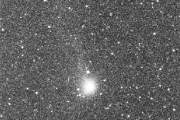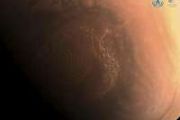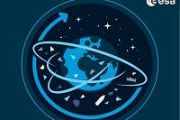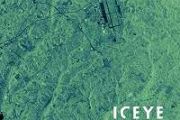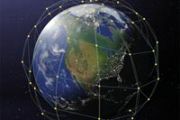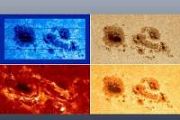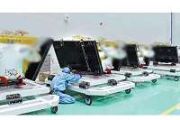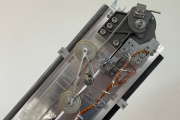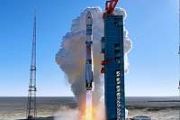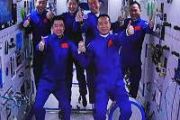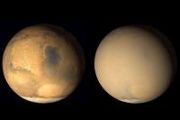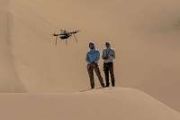
Copernical Team
Tumbleweed rover tests demonstrate transformative technology for low-cost Mars exploration
This request seems a bit unusual, so we need to confirm that you're human. Please press and hold the button until it turns completely green. Thank you for your cooperation!
Press and hold the button
If you believe this is an error, please contact our support team.
185.132.36.159 : 2a78a9cb-5209-4939-bed9-c8d2de17
Double launch day complete with SpaceX, ULA successes
This request seems a bit unusual, so we need to confirm that you're human. Please press and hold the button until it turns completely green. Thank you for your cooperation!
Press and hold the button
If you believe this is an error, please contact our support team.
185.132.36.159 : 4ea82f13-aec9-47f6-858f-e5e998b4
Space dynamics lab shares open-source software to detect potentially dangerous meteors
This request seems a bit unusual, so we need to confirm that you're human. Please press and hold the button until it turns completely green. Thank you for your cooperation!
Press and hold the button
If you believe this is an error, please contact our support team.
185.132.36.159 : 6169431f-56f2-4e9e-88d5-2b4f87df
Space: Framatome and ENEA sign MoU to explore advanced technological solutions for designing lunar nuclear fission reactors
 Framatome and ENEA, Italy's Agency for New Technologies, Energy and Sustainable Development, have signed a memorandum of understanding to jointly explore advanced technologies for lunar surface nuclear fission reactors. The agreement is intended to support future human settlements on the Moon with reliable, long-duration power systems.
Nuclear fission is seen as a key enabler for lunar ope
Framatome and ENEA, Italy's Agency for New Technologies, Energy and Sustainable Development, have signed a memorandum of understanding to jointly explore advanced technologies for lunar surface nuclear fission reactors. The agreement is intended to support future human settlements on the Moon with reliable, long-duration power systems.
Nuclear fission is seen as a key enabler for lunar ope Interstellar objects may hold key to accelerating giant planet growth around young stars
 Interstellar objects such as 3I/ATLAS, when captured in the planet-forming discs of young stars, may serve as the building blocks of giant planets, offering a solution to a long-standing problem in planet formation theory.
These wandering asteroid- and comet-like bodies are ejected from their home systems and drift through interstellar space, occasionally crossing into other star systems.
Interstellar objects such as 3I/ATLAS, when captured in the planet-forming discs of young stars, may serve as the building blocks of giant planets, offering a solution to a long-standing problem in planet formation theory.
These wandering asteroid- and comet-like bodies are ejected from their home systems and drift through interstellar space, occasionally crossing into other star systems. Gaia delivers first 3D fly through map of star forming regions in the Milky Way
 Scientists have produced the most detailed three-dimensional map yet of stellar nurseries within our galaxy, using data from the European Space Agency's Gaia mission. The new model reveals how massive young stars interact with interstellar clouds, transforming our understanding of star-forming environments.
Studying stellar birthplaces has always been challenging, since thick gas and dust
Scientists have produced the most detailed three-dimensional map yet of stellar nurseries within our galaxy, using data from the European Space Agency's Gaia mission. The new model reveals how massive young stars interact with interstellar clouds, transforming our understanding of star-forming environments.
Studying stellar birthplaces has always been challenging, since thick gas and dust AI model predicts harmful solar winds with unprecedented accuracy
 Scientists at NYU Abu Dhabi have built an artificial intelligence system capable of predicting solar wind speeds up to four days in advance with far greater accuracy than existing methods. Their findings are published in The Astrophysical Journal Supplement Series.
Solar wind, a constant stream of charged particles from the Sun, can intensify into powerful events that disrupt Earth's atmos
Scientists at NYU Abu Dhabi have built an artificial intelligence system capable of predicting solar wind speeds up to four days in advance with far greater accuracy than existing methods. Their findings are published in The Astrophysical Journal Supplement Series.
Solar wind, a constant stream of charged particles from the Sun, can intensify into powerful events that disrupt Earth's atmos Rare Einstein cross with central image uncovers dark matter halo
 Astronomers have identified an extraordinary Einstein Cross containing a fifth image, pointing to the presence of a massive halo of dark matter. The finding, led by an international team including Rutgers researchers, is published in The Astrophysical Journal.
An Einstein Cross typically forms when the gravity of foreground galaxies bends light from a background galaxy into four distinct i
Astronomers have identified an extraordinary Einstein Cross containing a fifth image, pointing to the presence of a massive halo of dark matter. The finding, led by an international team including Rutgers researchers, is published in The Astrophysical Journal.
An Einstein Cross typically forms when the gravity of foreground galaxies bends light from a background galaxy into four distinct i Amateur astronomers help track asteroid to French impact site
 With help from amateur astronomers, scientists tracked how an asteroid travelled from space, broke up in Earth's atmosphere and sent fiery fragments shooting to the ground, gathering new information about how these space rocks disintegrate.
Asteroid 2023 CX1 briefly lit up the sky as it disintegrated over northwestern France at around 4:00 pm (1400 GMT) on February 13, 2023.
Seven hours
With help from amateur astronomers, scientists tracked how an asteroid travelled from space, broke up in Earth's atmosphere and sent fiery fragments shooting to the ground, gathering new information about how these space rocks disintegrate.
Asteroid 2023 CX1 briefly lit up the sky as it disintegrated over northwestern France at around 4:00 pm (1400 GMT) on February 13, 2023.
Seven hours SpaceX, ULA plan rocket launches Thursday morning from Cape Canaveral
 Two rocket launches with satellites by Space X and United Launch Alliance are scheduled for Thursday morning from Cape Canaveral Space Force Station in Central Florida.
SpaceX is scheduled to lift off at 4:36 EDT with a Falcon 9 rocket taking 28 Starlink satellites into low-Earth orbit from Launch Complex 40. There is a four-hour launch window. This is the 22nd flight scheduled for the
Two rocket launches with satellites by Space X and United Launch Alliance are scheduled for Thursday morning from Cape Canaveral Space Force Station in Central Florida.
SpaceX is scheduled to lift off at 4:36 EDT with a Falcon 9 rocket taking 28 Starlink satellites into low-Earth orbit from Launch Complex 40. There is a four-hour launch window. This is the 22nd flight scheduled for the 






